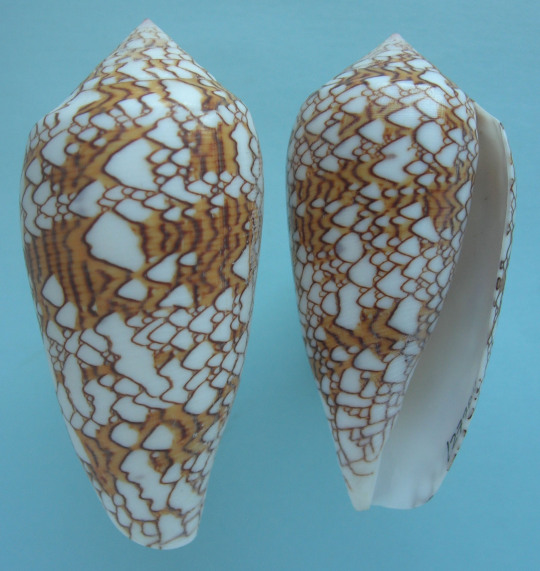By Tim Pearce
Cone snails live in the sea and inject venom to paralyze their prey. Most cone snails eat worms, some eat other snails, and some catch and eat fish. They use a hypodermic dart (a modified radular tooth) to inject venom. The venom contains about 100 different peptides (short proteins) that act as neurotoxins. Each of the 600 or so species of cone snail has its own unique cocktail of peptides, with very little overlap of peptides among species, yielding >50,000 peptides among the cone snails of the world.
Cone snail venom peptides are among the most rapidly evolving protein-coding genes in animals. They evolve twice as fast as most other known proteins. The rapid evolution appears to result from extensive gene duplications that provide abundant opportunities for natural selection during predator-prey interactions [1,2].
Furthermore, cone venom peptides are one of the most highly post-translationally modified classes of gene products known. That means the peptides undergo extensive modifications after being translated from DNA, including bromination, glycosylation, and amino acid epimerization (changing from L to D, like becoming their own mirror image) [3].
The venom cocktail targets particular kinds of prey; worm-eaters have a different suite of peptides than fish eaters. At different stages of development, they can express different genes. When very young, the fish eaters are too small to eat fish, so they eat worms, then switch to fish later. Their venom cocktail changes from worm toxins to fish toxins when they switch prey.

Conus magus is one of the species whose diet shifts from worms to fish as it grows. In these diet-shifting species, the shape of the radular dart changes as well – those eating worms have unbarbed darts, while those eating fish have backward pointing barbs to help keep hold of the fish [2,4,5].
Animal nerve cells contain many kinds of ion channels, whose function aids in transmitting signals along the nerve. Each cone snail peptide can target a particular kind of ion channel. The complex mixture of peptides in cone snail venom blocks many ion channels and neuron receptors in prey species. Surprisingly, many cone snail peptides act on pain targets, but it is not clear what advantage the snail would derive from numbing the prey’s pain. However, pain-killing properties are one of the reasons that cone snail venoms are of great interest to pharmaceutical companies and at least one cone snail peptide is currently used as a pain-killer in humans.
Researchers can prospect for venom peptides in the DNA of cone snail tissue snips or from museum specimens. By prospecting in DNA, they can find genes for venom peptides that are not being expressed at that particular life stage [6]. Once a useful peptide is discovered and characterized, it can be manufactured (so it doesn’t need to be milked from the snail).
Cone snails can switch rapidly between toxins for predation or toxins for defense. The toxins used by the geography cone, Conus geographus for catching prey are mostly inactive on humans, but the toxins it uses for defense are paralytic peptides that block neuromuscular receptors. Conus geographus and Conus textile are the two cone snail species known to kill humans [7].
To see videos of cone snails catching and swallowing fish, type into your internet browser: “cone snail eating.”
In addition to their beauty and amazing prey capture abilities, cone snails are remarkable for the extremely rapid evolution of their toxins, some of which show promise as useful medicines.
Timothy A. Pearce, PhD, is the head of the mollusks section at Carnegie Museum of Natural History. Museum employees are encouraged to blog about their unique experiences and knowledge gained from working at the museum.
Notes:
[1] Duda, T.F. & Palumbi, S.R. 1999. Molecular genetics of ecological diversification: Duplication and rapid evolution of toxin genes of the venomous gastropod Conus. Proceedings of the National Academy of Sciences, U.S.A., 96(12): 6820–6823.
[2] Chang, D.& Duda, T.F., Jr. 2016. Age-related association of venom gene expression and diet of predatory gastropods. BMC Evolutionary Biology, 16: 27.
[3] Buczek, O., Yoshikami, D., Bulaj, G., Jimenez, E.C. & Olivera, B.M. 2005. Posttranslational amino acid isomerization: a functionally important D-amino acid in an excitatory peptide. Journal of Biological Chemistry, 280: 4247-4253.
[4] Nybakken, J. & Perron, F. 1988. Ontogenetic change in the radula of Conus magus(Gastropoda). Marine Biology, 98(2): 239–242
[5] Nybakken, J. 1990. Ontogenetic change in the Conusradula, its form, distribution among the radula types, and significance in systematics and ecology. Malacologia, 32(1): 35-54.
[6] I suspect that post-translational effects (including introns and exons) would obscure the understanding of the final product of a peptide discovered by DNA prospecting.
[7]Dutertre, S., Jin, A.-H., Vetter, I., Hamilton, B., Sunagar, K., Lavergne, V., Dutertre, V., Fry, B.G., Antunes, A., Venter, D.J., Alewood, P.F. & Lewis, R.J. 2014. Evolution of separate predation- and defence-evoked venoms in carnivorous cone snails. Nature Communications, 5(3521): 1-9.
